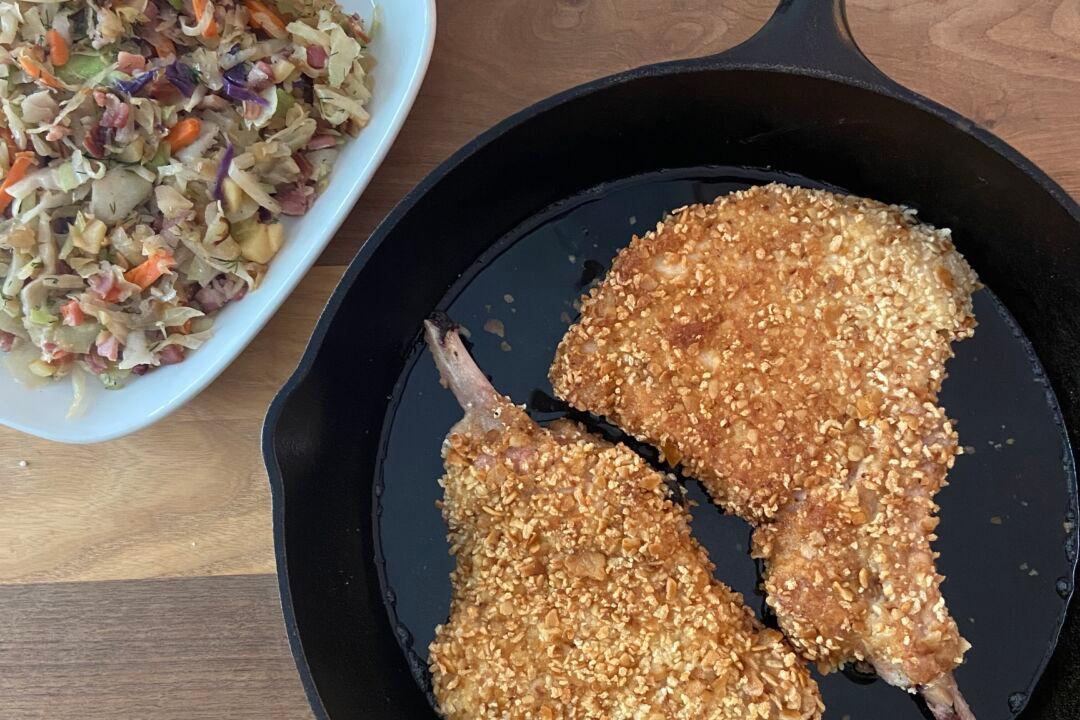You might say we schnitzeled our way through Munich on a recent trip. Between the four of us, someone ordered a schnitzel entree every day. Sometimes we ordered the dish made with classic thinly pounded veal. More often, chicken cutlets, eggplant slices, slabs of kohlrabi, and pork chops. Turns out, many foods embrace the crunchy exterior coating and a brief stint in hot oil as the archetypal.
Wiener schnitzel, a Viennese classic (wiener means Viennese) may have its home in Austria, but is a mainstay throughout much of Germany. Jean Anderson, in “The New German Cookbook,” tells us that the hallmark of a well-made schnitzel is a crumb coating that crisps and browns yet doesn’t stick to the meat with a gummy layer.
Boneless cutlets of veal, pork, or chicken prove easy to schnitzel. Likewise, thin slabs of meaty vegetables, such as kohlrabi or eggplant, take nicely to this preparation, as do hearty fish fillets. Bone-in pork chops make one of the most impressive schnitzel presentations.
Like schnitzel’s Japanese counterpart, katsu, or milanesa, Mexico and Argentina’s crumbed and fried favorite, a three-stage breading ensures moist meat (or veg) and an impressive crust. It sounds difficult, but really, it’s just a bit messy: one bowl of seasoned flour, one bowl of seasoned eggs, and a bowl of seasoned crunchy crumbs.
Speaking of crumbs, there are many options. Fine, dry breadcrumbs make a finely textured crust. Panko, Japanese-style breadcrumbs, tend to remain crunchier in the final dish. Stirring in a portion of finely ground pretzels enhances the flavor of anything you choose to schnitzel.
Fortunately for the cook, coating the chops or cutlets in advance actually helps set them crisp better. In fact, the coated food can be set on a rack over a baking sheet and then refrigerated up to several hours before cooking.
The right cooking fat makes all the difference, too. Always use a vegetable oil suitable for high-heat cooking, such as safflower, sunflower, or expeller-pressed canola. Some restaurants choose to deep-fry their schnitzel. At home, I prefer a shallow pan-fry to help minimize mess and odors. A very large, well-seasoned cast-iron skillet allows me to cook with minimal fat in a single, uncrowded layer.
Pork Chop Schnitzel With Pretzel Crumbs
Note: I put a fork into each bowl to use for the three-stage dredging method to help coat the pork slices evenly with minimal mess.- 4 bone-in pork rib chops, about 1-inch thick and 8 ounces each, bones frenched
- Salt, freshly ground black pepper
- 3 cups flat pretzel crisps, about 4 ounces
- 1 cup panko (Japanese-style bread crumbs)
- 1/2 cup flour
- 2 large eggs
- 2 tablespoons milk or half-and-half
- Peanut or expeller-pressed canola oil or safflower oil, for frying
- Lemon wedges, for serving
- Sliced pickles, for serving
- Assorted mustards, for serving
Put pretzels into a food processor or blender. Process with on/off turns until pulverized to fine crumbs. Add panko crumbs and process to mix together. Put into a shallow bowl or pie plate.
Mix flour, 1/2 teaspoon salt, and freshly ground pepper to taste in a second shallow plate. Mix eggs, milk, 1/2 teaspoon salt, and pepper to taste in a third shallow dish.
Set a wire rack over a baking sheet.
Use a fork to lightly dredge each pork chop on both sides with flour mixture. Then, dip the chop into eggs to coat well, then let excess egg drain back into the bowl. Then thoroughly dredge the chop in the crumb mixture to cover all sides completely. Put the coated chop onto the rack set over the baking sheet. Repeat to coat all the chops.
Let pork stand about 20 minutes at room temperature, or refrigerate uncovered up to several hours.
Just before serving, heat oven to 200 degrees F. Have a paper-towel-lined baking sheet ready.
Heat 1/4 inch of oil in a very large cast-iron or nonstick skillet over medium heat. When the oil is hot enough to make the edge of a pork chop sizzle fiercely, add the pork chops in a single, uncrowded layer (usually 2 at a time). Cook over medium heat (do not let the oil smoke), without turning, until nicely golden on the bottom, about 3 minutes. Turn the pork and fry the second side until golden, about 2 minutes more. Remove to the prepared baking sheet and place in the oven. Repeat to cook remaining chops. Add more oil to the pan if needed to keep the 1/4-inch oil level.
Sautéed Cabbage With Bacon and Apples
Makes 4 servings- 1 tablespoon vegetable oil
- 3 slices applewood smoked bacon, diced
- 1/2 red onion, diced
- 1 package (14 ounces) shredded coleslaw mix with carrots and red cabbage
- 1 small apple, cored, diced
- 1 tablespoon minced fresh dill or 1 teaspoon dried dill
- 1/2 teaspoon salt
Stir in coleslaw mix and apple. Cover pan and cook, stirring often, until cabbage is tender, about 8 minutes. Season with dill and salt. Serve warm.







